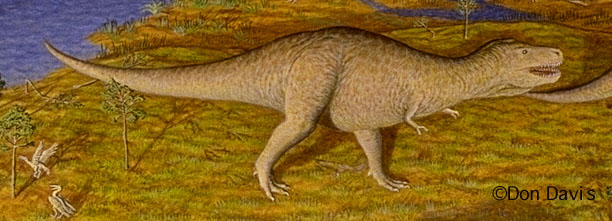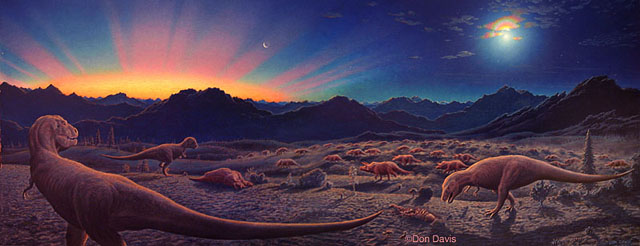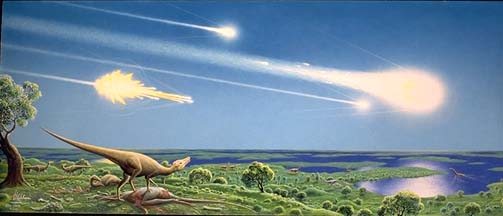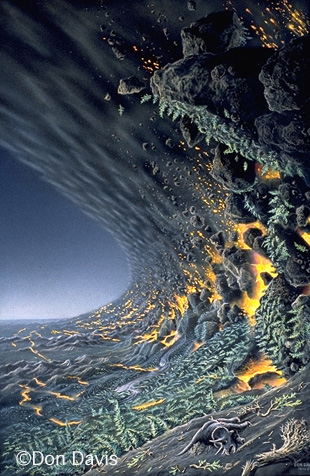
Please note: All my images on this site are copyrighted, unless specifically labeled as being in the 'Public Domain', such as in the case of my NASA art. You may download any of the images, use them in personal startup screens, and share them with friends so long as the copyright notices are not removed. They may not be used in any shareware, freeware, or commercial product, publication or other media without arrangements with the artist. I have high res files of these and many more works available upon inquiry.
Dinosaurs and their extinction

Naturally Dinosaurs have fascinated me all my life. At one time I wanted to be a paleontologist and dig up dinosaurs. later I decided it was more fun to draw them.
A series of plastic models of prehistoric animals were released by the Marx company about 1960, largely based on the paintings of Charles R. Knight, whose work was then in books I could see in school such as 'Life Through The Ages' or the 'stamp' color reproductions in the book from the 'Science Service' you could send for. Dinosaurs were very popular in toys and such in the early 1960's.
Life's 'The World We Live In' contained a reproduction of the great mural by Rudolph Zallinger at the Peabody Museum of Natural History at Yale University. This painting was an endlessly detailed panorama through time, reproduced at large scale in the book. As a child I would mentally explore the distant forests and mountains and the occasional faraway Dinosaur of this monumental work. Later I would see the painting more in terms of the deficiencies of the poses of the animals and of the geologic details seen between the plants. In retrospect perhaps the plants are the part of that work which still stands out to me. Later I was to hear that the original was done in egg tempera, and that it stunk up the place for months after its completion. In fact the much admired reproduction was of a tempora preliminary work, and when I finally saw good reproductions of the final work I actually preferred the preliminary!
I have dabbled only occasionally in Dinosaur painting, but I have gathered a large collection of skeletal drawings and such as well as coastline data for a project to animate the Earth through time. Here is an attempt at a late Cretaceous landscape backlit by a setting sun. If one had a telescope one could look at the Moon and see there was no Tycho crater ray pattern. There are numerous errors in this work, such as the stretching of the Pterosaur wing to the feet, it really extended only to the base of the leg.

As Cosmos was in progress scientific news was made of the discovery by Louis and Walter Alvarez of a world wide layer of Iridium enriched deposits exactly corresponding to the end of the Mesozoic, the age of Dinosaurs. The first widely circulated scenario to explain this Iridium deposit was that it was Extraterrestrial origin. Dale Russell and Wallace Tucker in 1971 suggested a supernova had happened a few tens of light years away and an expanding shell had 'roared' through the Solar System, playing havoc with magnetic fields, ozone layers, depositing the Iridium along the way. Life on Earth would be subject to ultraviolet exposure for an unknown length of time, with widespread extinctions.
I painted a late Cretaceous Supernova as it would appear during of the kind of twilights I had seen a few years before. As soon as the Sun sets the Supernova, perhaps 20 light years away, casts crisp shadows. Colored rings of light such as surround the full moon as it shines through thin high clouds are shown, the point source of the light promoting purer colors than normally seen. A herd of Triceratops thunders into the night, with nearby Tyrannosaurs looking for dinner. The mountains were patterned after the 'flatirons' near Boulder, since I had just visited a girlfriend in that area. Oil on board, finished 10/24/79. Used in the book 'Cosmos'.

Several months afterwards, the Iridium layer was given an even more dramatic Extraterrestrial explanation. Louis and Walter Alvarez presented a convincing case for an impact origin of the Iridium anomaly and later work has built up a fairly detailed scenario for this cataclysm which is known to have happened 64.98 million years ago, plus or minus about 50,000 years. My first painting showing this event was finished 4/15/80, and depicted the impact occurring in Mongolia, where some of the predatory dinosaurs lived whose large brains invited speculation on whether dinosaurs could ever have evolved intelligence.

Later I would create new paintings as elaborations of the story unfolded. I have painted various views of different stages of the event. My animation of this impact, now widely called the 'K-T Event', can be seen at the Smithsonian's Hall Of Meteors at Washington D.C.'s National Museum of Natural History. My depictions attempt to incorporate what we have learned to produce the closest thing to an eyewitness view as possible. Below are paintings of non survivable views from 'ground level. The first shows the tsunami wave following the impact, the other has the event occurring on dry land and in the process of reworking the landscape. Both views are too 'clean and neat', but there's no sense working hard to show you next to nothing.


Finally, one of my distant views, about 45 seconds after impact.
